Systematic Analysis of the BrHAT Gene Family and Physiological Characteristics of Brassica rapa L. Treated with Histone Acetylase and Deacetylase Inhibitors under Low Temperature
Abstract
:1. Introduction
2. Results
2.1. Genome-Wide Identification and Phylogenetic Analysis of BrHAT Genes
2.2. Conserved Domains, Structure, and Replicate Sequences of BrHAT Genes
2.3. Analysis of Covariance within and between Species in BrHAT Genes
2.4. Expression Analysis of BrHATs under Abiotic Stress
2.5. Gene Ontology (GO) Enrichment Analysis of BrHAT Genes
2.6. Protein Interaction Prediction of BrHAT Genes
2.7. Effects of Different Inhibitor Treatments on HAT and HDAC Activities in B. rapa L.
2.8. Effects of Inhibitor Treatments on the Seed Germination and Growth of Different Cold-Resistant Varieties
2.9. Effect of Exogenous Inhibitors on Antioxidant Enzyme Activities in B. rapa L.
2.10. Effect of Exogenous Curcumin Application on the Soluble Matter Content of B. rapa L.
2.11. Expression Analysis of BrHATs after Inhibitor Treatment
3. Discussion
3.1. Analysis of HAT Genes in B. rapa L.
3.2. Relationships between HAT and HDAC Activities and Cold Tolerance
3.3. Effects of TSA Treatment on the Growth, Development, and Physiological Indexes of B. rapa L.
3.4. Effects of Curcumin Treatment on the Growth, Development, and Physiological Indexes of B. rapa L.
3.5. The Role of BrHATs in Growth, Development, and the Response to Low-Temperature Stress
4. Materials and Methods
4.1. HAT Gene Identification and Analysis of Phylogenetic Relationships, Chromosomal Location, Conserved Domains, and Gene Structure
4.2. Plant Materials, Growth Conditions, and Treatments
- TSA treatment
- B.
- Curcumin treatment
4.3. Analysis of Biochemical Indexes
4.4. Expression Pattern Analysis of BrHATs
5. Conclusions
Supplementary Materials
Author Contributions
Funding
Institutional Review Board Statement
Informed Consent Statement
Data Availability Statement
Acknowledgments
Conflicts of Interest
References
- Ma, L.; Wang, X.; Pu, Y.; Wu, J.; Coulter, J.A.; Li, X.; Wang, L.; Liu, L.; Fang, Y.; Niu, Z.; et al. Ecological and economic benefits of planting winter rapeseed (Brassica rapa L.) in the wind erosion area of northern China. Sci. Rep. 2019, 9, 20272. [Google Scholar] [CrossRef] [PubMed]
- Bewick, A.J.; Ji, L.; Niederhuth, C.E.; Willing, E.-M.; Hofmeister, B.T.; Shi, X.; Wang, L.; Lu, Z.; Rohr, N.A.; Hartwig, B.; et al. On the origin and evolutionary consequences of gene body DNA methylation. Proc. Natl. Acad. Sci. USA 2016, 113, 9111–9116. [Google Scholar] [CrossRef] [PubMed]
- Chang, Y.N.; Zhu, C.; Jiang, J.; Zhang, H.; Zhu, J.K.; Duan, C.G. Epigenetic regulation in plant abiotic stress responses. J. Integr. Plant Biol. 2020, 62, 563–580. [Google Scholar] [CrossRef]
- Xing, G.; Jin, M.; Qu, R.; Zhang, J.; Han, Y.; Han, Y.; Wang, X.; Li, X.; Ma, F.; Zhao, X. Genome-wide investigation of histone acetyltransferase gene family and its responses to biotic and abiotic stress in foxtail millet (Setaria italica [L.] P. Beauv). BMC Plant Biol. 2022, 22, 292. [Google Scholar] [CrossRef]
- Liu, L.; Pu, Y.; Niu, Z.; Wu, J.; Fang, Y.; Xu, J.; Xu, F.; Yue, J.; Ma, L.; Li, X.; et al. Transcriptomic Insights Into Root Development and Overwintering Transcriptional Memory of Brassica rapa L. Grown in the Field. Front. Plant Sci. 2022, 13, 900708. [Google Scholar] [CrossRef] [PubMed]
- Zhu, M.; Monroe, J.G.; Suhail, Y.; Villiers, F.; Mullen, J.; Pater, D.; Hauser, F.; Jeon, B.W.; Bader, J.S.; Kwak, J.M.; et al. Molecular and systems approaches towards drought-tolerant canola crops. New Phytol. 2016, 210, 1169–1189. [Google Scholar] [CrossRef] [PubMed]
- Wang, J.; Jiao, J.; Zhou, M.; Jin, Z.; Yu, Y.; Liang, M. Physiological and Transcriptional Responses of Industrial Rapeseed (Brassica napus) Seedlings to Drought and Salinity Stress. Int. J. Mol. Sci. 2019, 20, 5604. [Google Scholar] [CrossRef]
- Pan, J.; Zhang, L.; Chen, M.; Ruan, Y.; Li, P.; Guo, Z.; Liu, B.; Ruan, Y.; Xiao, M.; Huang, Y. Identification and charactering of APX genes provide new insights in abiotic stresses response in Brassica napus. PeerJ 2022, 10, e13166. [Google Scholar] [CrossRef]
- Ali, I.; Conrad, R.J.; Verdin, E.; Ott, M. Lysine Acetylation Goes Global: From Epigenetics to Metabolism and Therapeutics. Chem. Rev. 2018, 118, 1216–1252. [Google Scholar] [CrossRef]
- Zhang, X.; Wan, Q.; Liu, F.; Zhang, K.; Sun, A.; Luo, B.; Sun, L.; Wan, Y. Molecular analysis of the chloroplast Cu/Zn-SOD gene (AhCSD2) in peanut. Crop J. 2015, 3, 246–257. [Google Scholar] [CrossRef]
- Wu, C.-L.; Lin, L.-F.; Hsu, H.-C.; Huang, L.-F.; Hsiao, C.-D.; Chou, M.-L. Saussurea involucrata (Snow Lotus) ICE1 and ICE2 Orthologues Involved in Regulating Cold Stress Tolerance in Transgenic Arabidopsis. Int. J. Mol. Sci. 2021, 22, 10850. [Google Scholar] [CrossRef] [PubMed]
- Hwarari, D.; Guan, Y.; Ahmad, B.; Movahedi, A.; Min, T.; Hao, Z.; Lu, Y.; Chen, J.; Yang, L. ICE-CBF-COR Signaling Cascade and Its Regulation in Plants Responding to Cold Stress. Int. J. Mol. Sci. 2022, 23, 1549. [Google Scholar] [CrossRef] [PubMed]
- Cui, K.; Xu, L.; Tao, T.; Huang, L.; Li, J.; Hong, J.; Li, H.; Chi, Y. Mechanical behavior of multiscale hybrid fiber reinforced recycled aggregate concrete subject to uniaxial compression. J. Build. Eng. 2023, 71, 106504. [Google Scholar] [CrossRef]
- Kong, L.; Liu, Y.; Wang, X.; Chang, C. Insight into the Role of Epigenetic Processes in Abiotic and Biotic Stress Response in Wheat and Barley. Int. J. Mol. Sci. 2020, 21, 1480. [Google Scholar] [CrossRef]
- Pandey, R.; Muller, A.; Napoli, C.A.; Selinger, D.A.; Pikaard, C.S.; Richards, E.J.; Bender, J.; Mount, D.W.; Jorgensen, R.A. Analysis of histone acetyltransferase and histone deacetylase families of Arabidopsis thaliana suggests functional diversification of chromatin modification among multicellular eukaryotes. Nucleic Acids Res. 2002, 30, 5036–5055. [Google Scholar] [CrossRef] [PubMed]
- Yuan, L.; Liu, X.; Luo, M.; Yang, S.; Wu, K. Involvement of histone modifications in plant abiotic stress responses. J. Integr. Plant Biol. 2013, 55, 892–901. [Google Scholar] [CrossRef] [PubMed]
- Zhu, X.; Li, Q.; Chang, R.; Yang, D.; Song, Z.; Guo, Q.; Huang, C. Curcumin Alleviates Neuropathic Pain by Inhibiting p300/CBP Histone Acetyltransferase Activity-Regulated Expression of BDNF and Cox-2 in a Rat Model. PLoS ONE 2014, 9, e91303. [Google Scholar] [CrossRef]
- Balasubramanyam, K.; Varier, R.A.; Altaf, M.; Swaminathan, V.; Siddappa, N.B.; Ranga, U.; Kundu, T.K. Curcumin, a Novel p300/CREB-binding Protein-specific Inhibitor of Acetyltransferase, Represses the Acetylation of Histone/Nonhistone Proteins and Histone Acetyltransferase-dependent Chromatin Transcription. J. Biol. Chem. 2004, 279, 51163–51171. [Google Scholar] [CrossRef]
- Ailenberg, M.; Silverman, M. Trichostatin A—Histone deacetylase inhibitor with clinical therapeutic potential—Is also a selective and potent inhibitor of gelatinase A expression. Biochem. Biophys. Res. Commun. 2002, 298, 110–115. [Google Scholar] [CrossRef]
- Deng, Z.; Liu, X.; Jin, J.; Xu, H.; Gao, Q.; Wang, Y.; Zhao, J. Histone Deacetylase Inhibitor Trichostatin a Promotes the Apoptosis of Osteosarcoma Cells through p53 Signaling Pathway Activation. Int. J. Biol. Sci. 2016, 12, 1298–1308. [Google Scholar] [CrossRef]
- Hu, Y.; Lu, Y.; Zhao, Y.; Zhou, D.-X. Histone Acetylation Dynamics Integrates Metabolic Activity to Regulate Plant Response to Stress. Front. Plant Sci. 2019, 10, 1236. [Google Scholar] [CrossRef] [PubMed]
- Kölle, D.; Sarg, B.; Lindner, H.; Loidl, P. Substrate and sequential site specificity of cytoplasmic histone acetyltransferases of maize and rat liver. FEBS Lett. 1998, 421, 109–114. [Google Scholar] [CrossRef] [PubMed]
- Lusser, A.; Eberharter, A.; Loidl, A.; Schramel, M.G.; Horngacher, M.; Haas, H.; Loidl, P. Analysis of the histone acetyltransferase B complex of maize embryos. Nucleic Acids Res. 1999, 27, 4427–4435. [Google Scholar] [CrossRef]
- Marmorstein, R. Structure and function of histone acetyltransferases. Cell. Mol. Life Sci. 2001, 58, 693–703. [Google Scholar] [CrossRef]
- Latham, J.A.; Dent, S.Y.R. Cross-regulation of histone modifications. Nat. Struct. Mol. Biol. 2007, 14, 1017–1024. [Google Scholar] [CrossRef]
- Allfrey, V.G.; Faulkner, R.; Mirsky, A.E. Acetylation and methylation of histones and their possible role in the regulation of rna synthesis. Proc. Natl. Acad. Sci. USA 1964, 51, 786–794. [Google Scholar] [CrossRef] [PubMed]
- Wei, J.; Zheng, G.; Yu, X.; Liu, S.; Dong, X.; Cao, X.; Fang, X.; Li, H.; Jin, J.; Mi, W.; et al. Comparative Transcriptomics and Proteomics Analyses of Leaves Reveals a Freezing Stress-Responsive Molecular Network in Winter Rapeseed (Brassica rapa L.). Front. Plant Sci. 2021, 12, 664311. [Google Scholar] [CrossRef]
- Pu, Y.; Liu, L.; Wu, J.; Zhao, Y.; Bai, J.; Ma, L.; Yue, J.; Jin, J.; Niu, Z.; Fang, Y.; et al. Transcriptome Profile Analysis of Winter Rapeseed (Brassica napus L.) in Response to Freezing Stress, Reveal Potentially Connected Events to Freezing Stress. Int. J. Mol. Sci. 2019, 20, 2771. [Google Scholar] [CrossRef]
- Zeng, X.; Xu, Y.; Jiang, J.; Zhang, F.; Ma, L.; Wu, D.; Wang, Y.; Sun, W. iTRAQ-Based Comparative Proteomic Analysis of the Roots of TWO Winter Turnip Rapes (Brassica rapa L.) with Different Freezing-Tolerance. Int. J. Mol. Sci. 2018, 19, 4077. [Google Scholar] [CrossRef]
- Wang, J.; Chitsaz, F.; Derbyshire, M.K.; Gonzales, N.R.; Gwadz, M.; Lu, S.; Marchler, G.H.; Song, J.S.; Thanki, N.; Yamashita, R.A.; et al. The conserved domain database in 2023. Nucleic Acids Res. 2022, 51, D384–D388. [Google Scholar] [CrossRef]
- Gamsjaeger, R.; Liew, C.; Loughlin, F.; Crossley, M.; Mackay, J. Sticky fingers: Zinc-fingers as protein-recognition motifs. Trends Biochem. Sci. 2007, 32, 63–70. [Google Scholar] [CrossRef] [PubMed]
- Jayaram, H.N.; Cooney, D.A.; A Ryan, J.; Neil, G.; Dion, R.L.; Bono, V.H. L-[alphaS, 5S]-alpha-amino-3-chloro-4,5-dihydro-5-isoxazoleacetic acid (NSC-163501): A new amino acid antibiotic with the properties of an antagonist of L-glutamine. Cancer Chemother. Rep. 1975, 59, 481–491. [Google Scholar] [PubMed]
- Latrasse, D.; Benhamed, M.; Henry, Y.; Domenichini, S.; Kim, W.; Zhou, D.-X.; Delarue, M. The MYST histone acetyltransferases are essential for gametophyte development in Arabidopsis. BMC Plant Biol. 2008, 8, 121. [Google Scholar] [CrossRef]
- Shamshad, A.; Rashid, M.; Zaman, Q.U. In-silico analysis of heat shock transcription factor (OsHSF) gene family in rice (Oryza sativa L.). BMC Plant Biol. 2023, 23, 395. [Google Scholar] [CrossRef]
- Hu, W.; Hou, X.; Huang, C.; Yan, Y.; Tie, W.; Ding, Z.; Wei, Y.; Liu, J.; Miao, H.; Lu, Z.; et al. Genome-Wide Identification and Expression Analyses of Aquaporin Gene Family during Development and Abiotic Stress in Banana. Int. J. Mol. Sci. 2015, 16, 19728–19751. [Google Scholar] [CrossRef]
- Sun, J.; Tian, Z.; Li, X.; Li, S.; Li, Z.; Wang, J.; Hu, Z.; Chen, H.; Guo, C.; Xie, M.; et al. Systematic analysis of the pectin methylesterase gene family in Nicotiana tabacum and reveal their multiple roles in plant development and abiotic stresses. Front. Plant Sci. 2022, 13, 998841. [Google Scholar] [CrossRef] [PubMed]
- Zhao, Z.; Zhu, J.; Li, J.; Li, Z.; Li, Y. Genome-wide Identification and Expressions under Stresses of RLCK VI Family in Gossypium barbadense. Fujian Agric. J. 2023, 38, 686–697. [Google Scholar]
- Pfaffl, M.W. A new mathematical model for relative quantification in real-time RT-PCR. Nucleic Acids Res. 2001, 29, e45. [Google Scholar] [CrossRef]
- Huo, C.; Zhang, B.; Wang, R. Research progress on plant noncoding RNAs in response to low-temperature stress. Plant Signal. Behav. 2021, 17, 2004035. [Google Scholar] [CrossRef]
- Ueda, M.; Seki, M. Histone Modifications Form Epigenetic Regulatory Networks to Regulate Abiotic Stress Response. Plant Physiol. 2019, 182, 15–26. [Google Scholar] [CrossRef]
- Kuo, M.H.; Allis, C.D. Roles of histone acetyltransferases and deacetylases in gene regulation. Bioessays 1998, 20, 615–626. [Google Scholar] [CrossRef] [PubMed]
- Liu, X.; Luo, M.; Zhang, W.; Zhao, J.; Zhang, J.; Wu, K.; Tian, L.; Duan, J. Histone acetyltransferases in rice (Oryza sativa L.): Phylogenetic analysis, subcellular localization and expression. BMC Plant Biol. 2012, 12, 145. [Google Scholar] [CrossRef]
- Kubo, T.; Yoshimura, A.; Kurata, N. Loss of OsEAF6, a Subunit of the Histone Acetyltransferase Complex, Causes Hybrid Breakdown in Intersubspecific Rice Crosses. Front. Plant Sci. 2022, 13, 866404. [Google Scholar] [CrossRef] [PubMed]
- Han, Y.; Georgii, E.; Priego-Cubero, S.; Wurm, C.J.; Hüther, P.; Huber, G.; Koller, R.; Becker, C.; Durner, J.; Lindermayr, C. Arabidopsis histone deacetylase HD2A and HD2B regulate seed dormancy by repressing DELAY OF GERMINATION 1. Front. Plant Sci. 2023, 14, 1124899. [Google Scholar] [CrossRef] [PubMed]
- Poulios, S.; Tsilimigka, F.; Mallioura, A.; Pappas, D.; Seira, E.; Vlachonasios, K. Histone Acetyltransferase GCN5 Affects Auxin Transport during Root Growth by Modulating Histone Acetylation and Gene Expression of PINs. Plants 2022, 11, 3572. [Google Scholar] [CrossRef] [PubMed]
- Hendrickson, W.A.; Ward, K.B. Atomic models for the polypeptide backbones of myohemerythrin and hemerythrin. Biochem. Biophys. Res. Commun. 1975, 66, 1349–1356. [Google Scholar] [CrossRef]
- Dincer, I.; Temiz, M. Energy, Environment, and Sustainable Development. In Renewable Energy Options for Power Generation and Desalination; Springer: Cham, Switzerland, 2024. [Google Scholar] [CrossRef]
- Huang, M.; Huang, J.; Zheng, Y.; Sun, Q. Histone acetyltransferase inhibitors: An overview in synthesis, structure-activity relationship and molecular mechanism. Eur. J. Med. Chem. 2019, 178, 259–286. [Google Scholar] [CrossRef]
- Hulse-Kemp, A.M.; Bostan, H.; Chen, S.; Ashrafi, H.; Stoffel, K.; Sanseverino, W.; Li, L.; Cheng, S.; Schatz, M.C.; Garvin, T.; et al. An anchored chromosome-scale genome assembly of spinach improves annotation and reveals extensive gene rearrangements in euasterids. Plant Genome 2021, 14, e20101. [Google Scholar] [CrossRef]
- Guo, M.; Wang, S.; Liu, H.; Yao, S.; Yan, J.; Wang, C.; Miao, B.; Guo, J.; Ma, F.; Guan, Q.; et al. Histone deacetylase MdHDA6 is an antagonist in regulation of transcription factor MdTCP15 to promote cold tolerance in apple. Plant Biotechnol. J. 2023, 21, 2254–2272. [Google Scholar] [CrossRef]
- Xu, C.-R.; Liu, C.; Wang, Y.-L.; Li, L.-C.; Chen, W.-Q.; Xu, Z.-H.; Bai, S.-N. Histone acetylation affects expression of cellular patterning genes in the Arabidopsis root epidermis. Proc. Natl. Acad. Sci. USA 2005, 102, 14469–14474. [Google Scholar] [CrossRef]
- Michaud, P.-A. Adolescent medicine in Guglera: A novel approach for unemployed, severely obese adolescents. Rev. Medicale Suisse 2010, 6, 120–122. [Google Scholar] [CrossRef]
- Nelson, S.K.; Ariizumi, T.; Steber, C.M. Biology in the Dry Seed: Transcriptome Changes Associated with Dry Seed Dormancy and Dormancy Loss in the Arabidopsis GA-Insensitive sleepy1-2 Mutant. Front. Plant Sci. 2017, 8, 2158. [Google Scholar] [CrossRef] [PubMed]
- Zhang, X.; Wang, K.; Ervin, E.; Waltz, C.; Murphy, T. Metabolic Changes During Cold Acclimation and Deacclimation in Five Bermudagrass Varieties. I. Proline, Total Amino Acid, Protein, and Dehydrin Expression. Crop Sci. 2011, 51, 838–846. [Google Scholar] [CrossRef]
- Kefu, Z.; Hai, F.; Ungar, I. Survey of halophyte species in China. Plant Sci. 2002, 163, 491–498. [Google Scholar] [CrossRef]
- Wang, L.; Yuan, J.; Ma, Y.; Jiao, W.; Ye, W.; Yang, D.-L.; Yi, C.; Chen, Z.J. Rice Interploidy Crosses Disrupt Epigenetic Regulation, Gene Expression, and Seed Development. Mol. Plant 2017, 11, 300–314. [Google Scholar] [CrossRef]
- Bose, K.S.; Sarma, R.H. Delineation of the intimate details of the backbone conformation of pyridine nucleotide coenzymes in aqueous solution. Biochem. Biophys. Res. Commun. 1975, 66, 1173–1179. [Google Scholar] [CrossRef]
- Liu, H.; Luo, J.; Fang, L.; Huang, H.; Deng, J.; Huang, J.; Zhang, S.; Li, Y.; Zheng, J. An electrochemical strategy with tetrahedron rolling circle amplification for ultrasensitive detection of DNA methylation. Biosens. Bioelectron. 2018, 121, 47–53. [Google Scholar] [CrossRef]
- Yu, Y.; Cao, H.; Zhang, M.; Shi, F.; Wang, R.; Liu, X. Prognostic value of DNA methylation for bladder cancer. Clin. Chim. Acta 2018, 484, 207–212. [Google Scholar] [CrossRef] [PubMed]
- Santos, H.P.; Nephew, B.C.; Bhattacharya, A.; Tan, X.; Smith, L.; Alyamani, R.A.S.; Martin, E.M.; Perreira, K.; Fry, R.C.; Murgatroyd, C. Discrimination exposure and DNA methylation of stress-related genes in Latina mothers. Psychoneuroendocrinology 2018, 98, 131–138. [Google Scholar] [CrossRef]
- Tulloch, J.; Leong, L.; Chen, S.; Keene, C.D.; Millard, S.P.; Shutes-David, A.; Lopez, O.L.; Kofler, J.; Kaye, J.A.; Woltjer, R.; et al. APOE DNA methylation is altered in Lewy body dementia. Alzheimer’s Dement. 2018, 14, 889–894. [Google Scholar] [CrossRef]
- El Baidouri, M.; Kim, K.D.; Abernathy, B.; Li, Y.-H.; Qiu, L.-J.; Jackson, S.A. Genic C-Methylation in Soybean Is Associated with Gene Paralogs Relocated to Transposable Element-Rich Pericentromeres. Mol. Plant 2018, 11, 485–495. [Google Scholar] [CrossRef] [PubMed]
- Huminiecki, L.; Horbańczuk, J.; Atanasov, A.G. The functional genomic studies of curcumin. Semin. Cancer Biol. 2017, 46, 107–118. [Google Scholar] [CrossRef] [PubMed]
- Mohajeri, M.; Sahebkar, A. Protective effects of curcumin against doxorubicin-induced toxicity and resistance: A review. Crit. Rev. Oncol. 2018, 122, 30–51. [Google Scholar] [CrossRef] [PubMed]
- Semik-Gurgul, E.; Ząbek, T.; Fornal, A.; Wnuk, M.; Pawlina-Tyszko, K.; Gurgul, A.; Klukowska-Rötzler, J.; Koch, C.; Mählmann, K.; Bugno-Poniewierska, M. DNA methylation patterns of the S100A14, POU2F3 and SFN genes in equine sarcoid tissues. Res. Vet. Sci. 2018, 119, 302–307. [Google Scholar] [CrossRef]
- Ak, T.; Gülçin, I. Antioxidant and radical scavenging properties of curcumin. Chem. Interact. 2008, 174, 27–37. [Google Scholar] [CrossRef] [PubMed]
- Bouyahya, A.; El Omari, N.; Bakha, M.; Aanniz, T.; El Menyiy, N.; El Hachlafi, N.; El Baaboua, A.; El-Shazly, M.; Alshahrani, M.M.; Al Awadh, A.A.; et al. Pharmacological Properties of Trichostatin A, Focusing on the Anticancer Potential: A Comprehensive Review. Pharmaceuticals 2022, 15, 1235. [Google Scholar] [CrossRef]
- Bailey, T.L.; Johnson, J.; Grant, C.E.; Noble, W.S. The MEME Suite. Nucleic Acids Res. 2015, 43, W39–W49. [Google Scholar] [CrossRef]
- Wu, J.; Xu, X.-D.; Liu, L.; Ma, L.; Pu, Y.; Wang, W.; Hua, X.-Y.; Song, J.-M.; Liu, K.; Lu, G.; et al. A Chromosome Level Genome Assembly of a Winter Turnip Rape (Brassica rapa L.) to Explore the Genetic Basis of Cold Tolerance. Front. Plant Sci. 2022, 13, 936958. [Google Scholar] [CrossRef] [PubMed]
- Hall, B.G. Building Phylogenetic Trees from Molecular Data with MEGA. Mol. Biol. Evol. 2013, 30, 1229–1235. [Google Scholar] [CrossRef] [PubMed]
- Wilkins, M.R.; Gasteiger, E.; Bairoch, A.; Sanchez, J.C.; Williams, K.L.; Appel, R.D.; Hochstrasser, D.F. Protein Identification and Analysis Tools in the ExPASy Server. In 2-D Proteome Analysis Protocols; Methods in Molecular Biology; Humana Press: Totowa, NJ, USA, 1999; Volume 112, pp. 531–552. [Google Scholar] [CrossRef]
- Chen, C.J.; Chen, H.; Zhang, Y.; Thomas, H.R.; Frank, M.H.; He, Y.H.; Xia, R. TBtools: An Integrative Toolkit Developed for Interactive Analyses of Big Biological Data. Mol. Plant 2020, 13, 1194–1202. [Google Scholar] [CrossRef]
- Lescot, M.; Déhais, P.; Thijs, G.; Marchal, K.; Moreau, Y.; Van de Peer, Y.; Rouzé, P.; Rombauts, S. PlantCARE, a database of plant cis-acting regulatory elements and a portal to tools for in silico analysis of promoter sequences. Nucleic Acids Res. 2002, 30, 325–327. [Google Scholar] [CrossRef]
- Chou, K.C.; Shen, H.B. Plant-Mploc: A top-down strategy to augment the power for predicting plant protein dubcellular localization. PLoS ONE 2010, 5, e11335. [Google Scholar] [CrossRef] [PubMed]
- Wang, W.P.; Ma, L.; Sun, B.L.; Guo, X.J.; Wang, S.F.; Niu, Z.X.; Qi, W.L.; Pu, Y.Y.; Lu, X.M.; Hu, F.D.; et al. Physiological mechanism of DNA demethylation in improving the cold resistance of Brassica rapa L. Agric. Res. Arid. Areas 2021, 39, 29–49. [Google Scholar] [CrossRef]
- Xu, F.; Liu, L.; Li, P.; Yao, Y.; Sun, W.; Wu, J. Identification and Expression Analysis of HDACs Gene Family in Winter Rapeseed (Brassica rapa L.). Acta Bot. Boreali-Occident. Sin. 2022, 42, 721–735. [Google Scholar] [CrossRef]
- Gasparov, V.S.; Degtiar, V.G. Opredelenie belka po sviazyvaniiu s krasitelem kumassi brilliantovym golubym G-250 [Protein determination by binding with the dye Coomassie brilliant blue G-250]. Biokhimiia 1994, 59, 763–777. [Google Scholar] [PubMed]
- Bor, M.; Özdemir, F.; Türkan, I. The effect of salt stress on lipid peroxidation and antioxidants in leaves of sugar beet Beta vulgaris L. and wild beet Beta maritima L. Plant Sci. 2003, 164, 77–84. [Google Scholar] [CrossRef]
- Demiral, T.; Türkan, I. Comparative lipid peroxidation, antioxidant defense systems and proline content in roots of two rice cultivars differing in salt tolerance. Environ. Exp. Bot. 2005, 53, 247–257. [Google Scholar] [CrossRef]
- Spitz, D.R.; Oberley, L.W. An assay for superoxide dismutase activity in mammalian tissue homogenates. Anal. Biochem. 1989, 179, 8–18. [Google Scholar] [CrossRef]
- Doerge, D.R.; Divi, R.L.; Churchwell, M.I. Identification of the Colored Guaiacol Oxidation Product Produced by Peroxidases. Anal. Biochem. 1997, 250, 10–17. [Google Scholar] [CrossRef]
- He, H.; Lei, Y.; Yi, Z.; Raza, A.; Zeng, L.; Yan, L.; Xiaoyu, D.; Yong, C.; Xiling, Z. Study on the mechanism of exogenous serotonin improving cold tolerance of rapeseed (Brassica napus L.) seedlings. Plant Growth Regul. 2021, 94, 161–170. [Google Scholar] [CrossRef]
- Ma, L.; Coulter, J.A.; Liu, L.; Zhao, Y.; Chang, Y.; Pu, Y.; Zeng, X.; Xu, Y.; Wu, J.; Fang, Y.; et al. Transcriptome Analysis Reveals Key Cold-Stress-Responsive genes in Winter Rapeseed (Brassica rapa L.). Int. J. Mol. Sci. 2019, 20, 1071. [Google Scholar] [CrossRef] [PubMed]
- Rao, X.; Huang, X.; Zhou, Z.; Lin, X. An improvement of the 2−ΔΔCT method for quantitative real-time polymerase chain reaction data analysis. Biostat. Bioinform. Biomath. 2013, 3, 71–85. [Google Scholar]

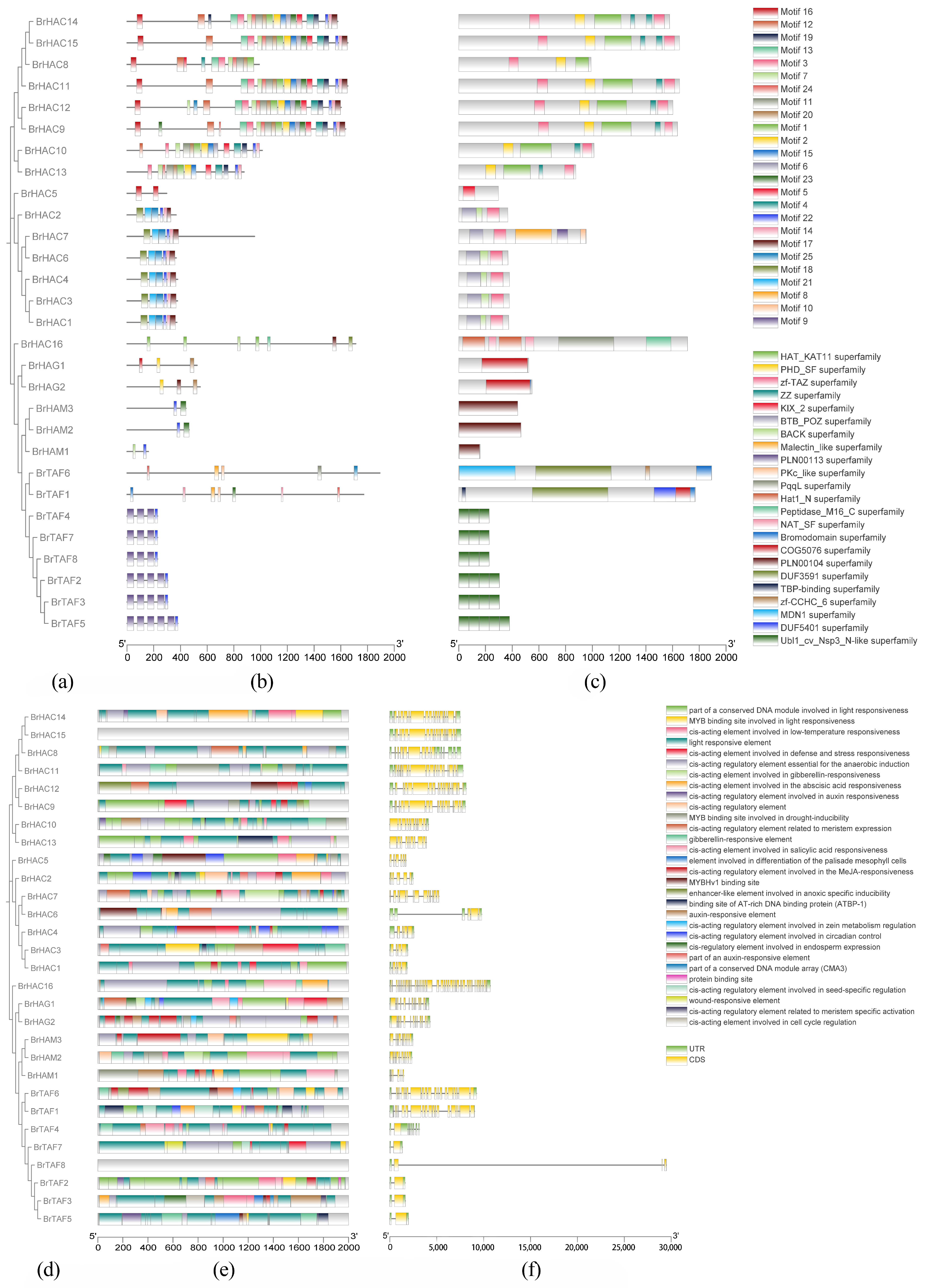

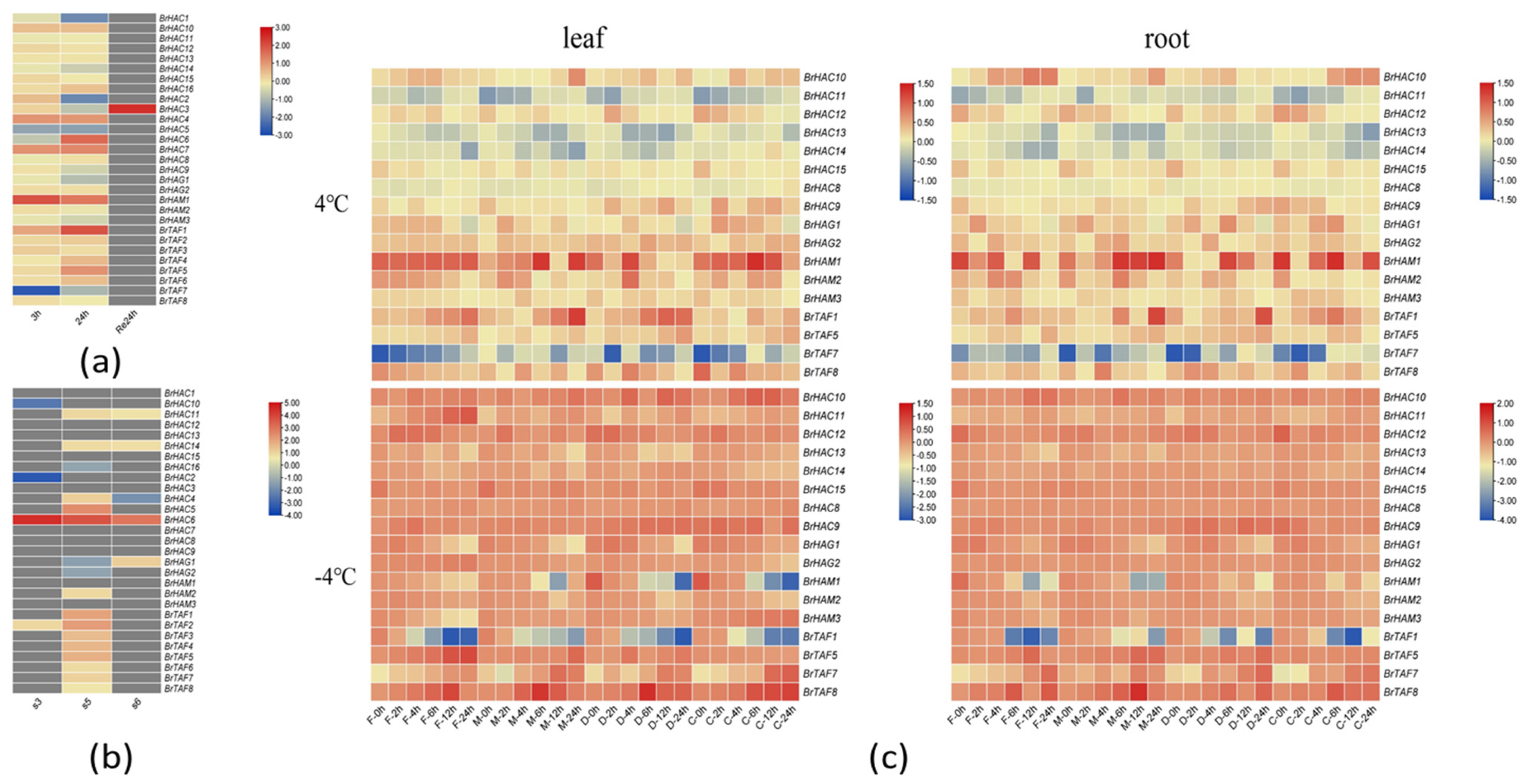
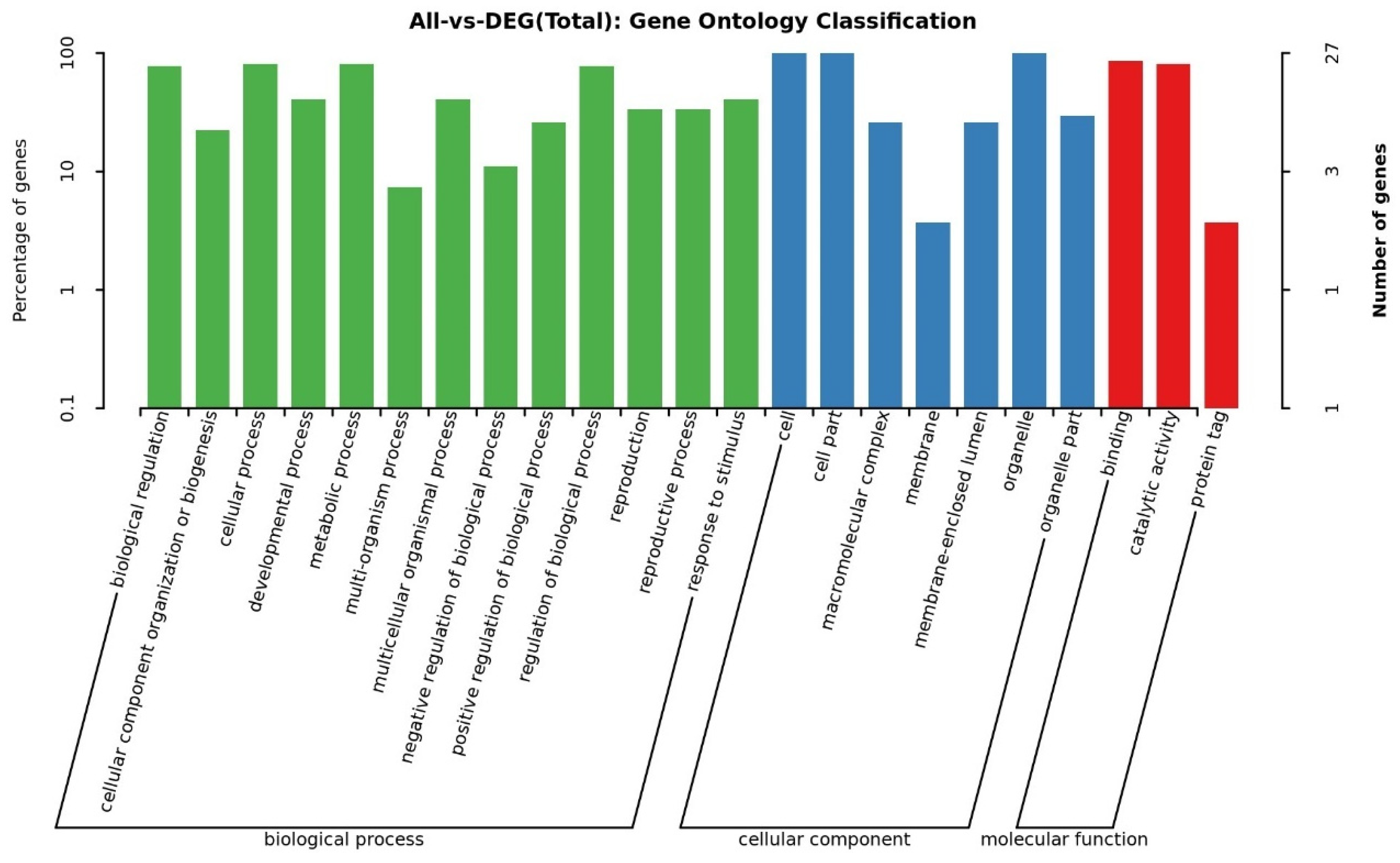
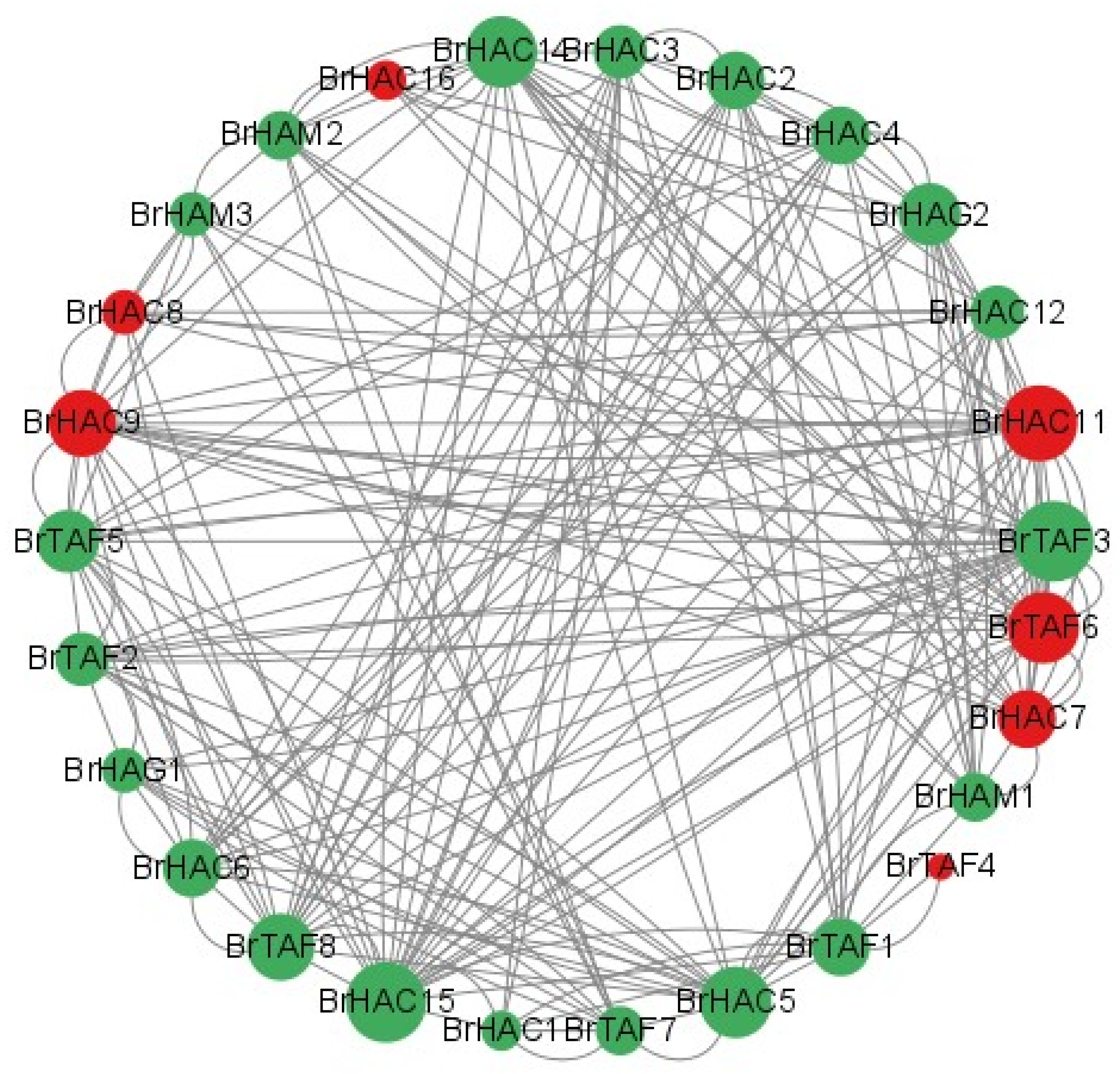

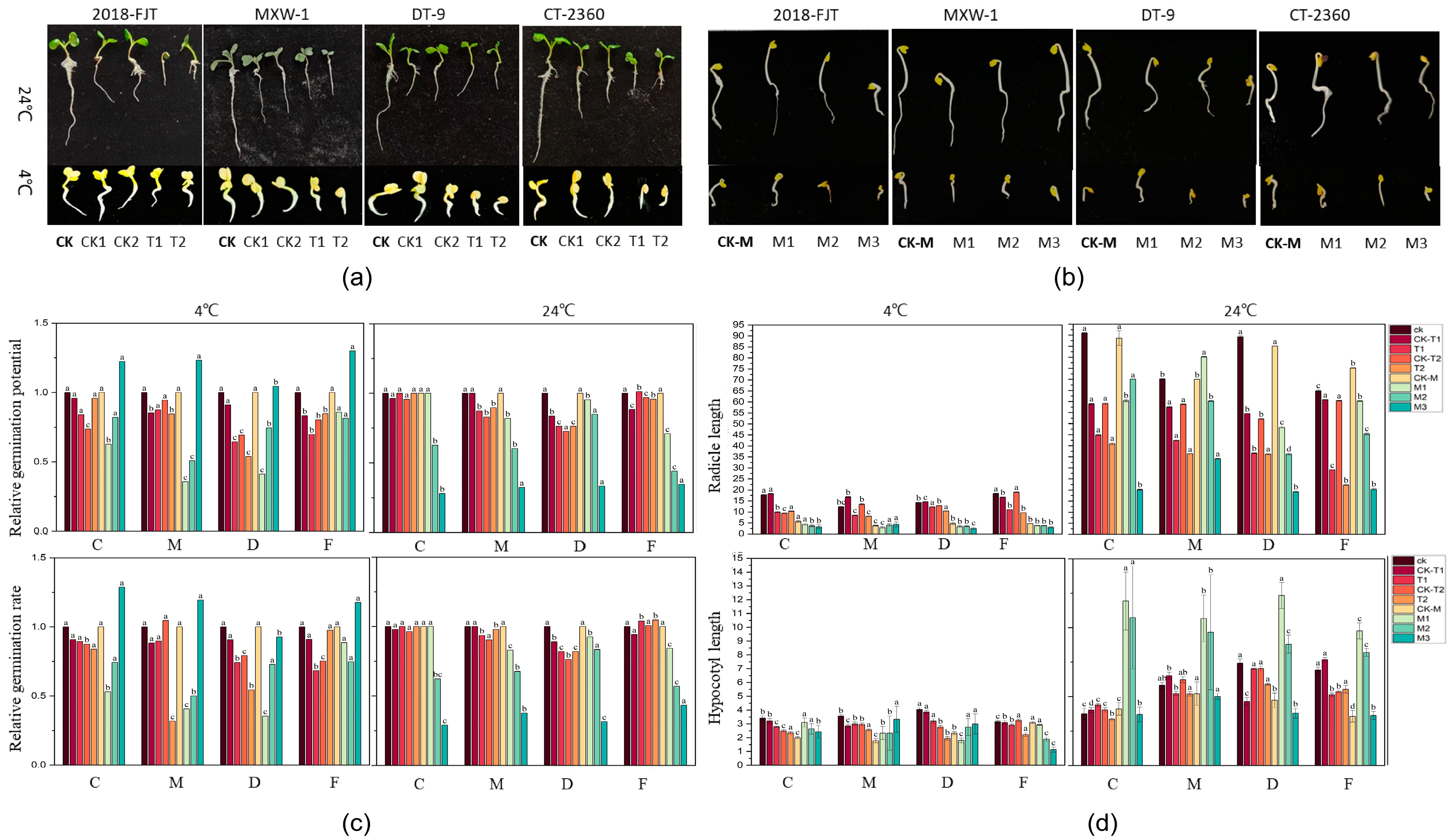
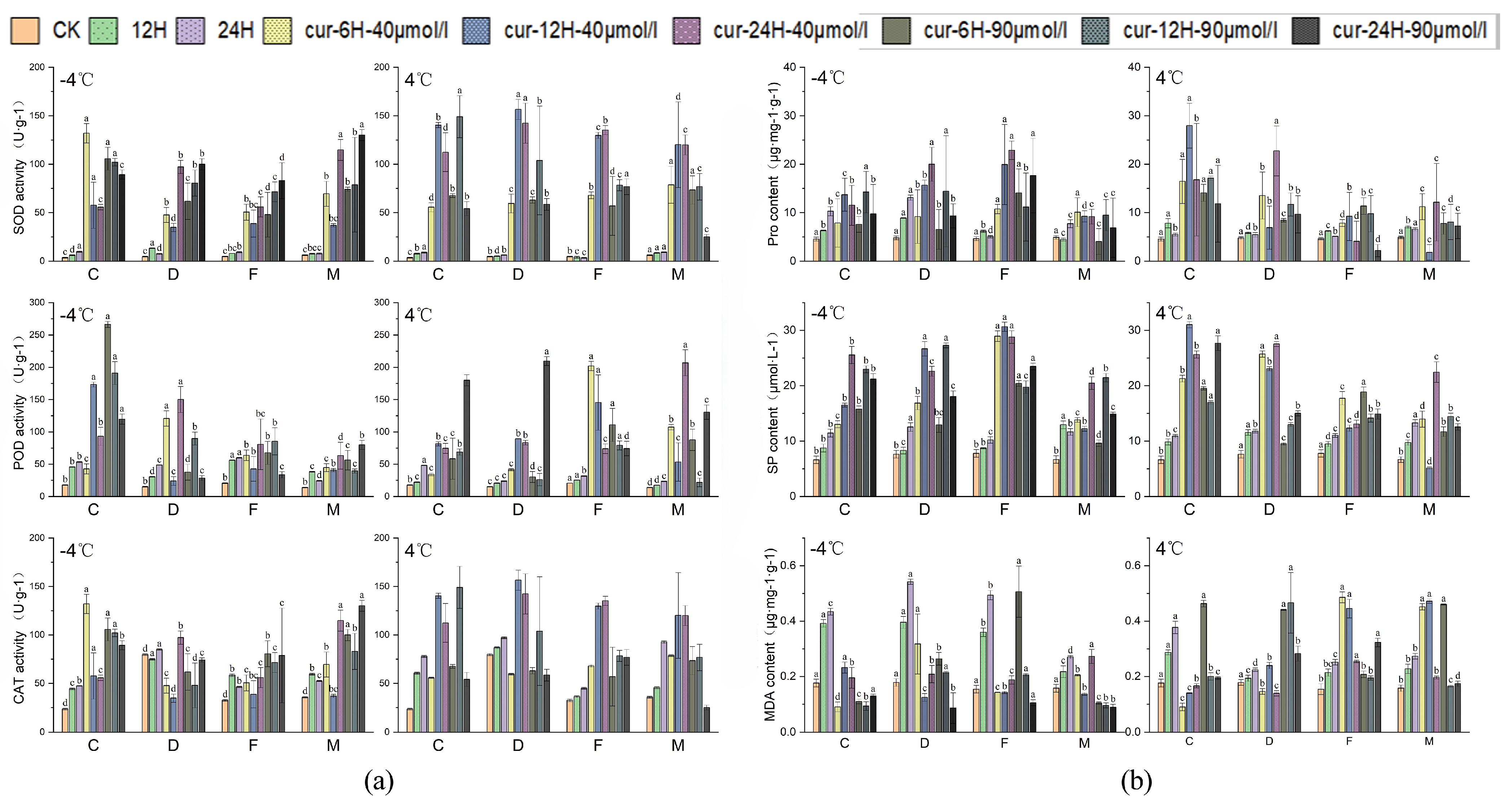
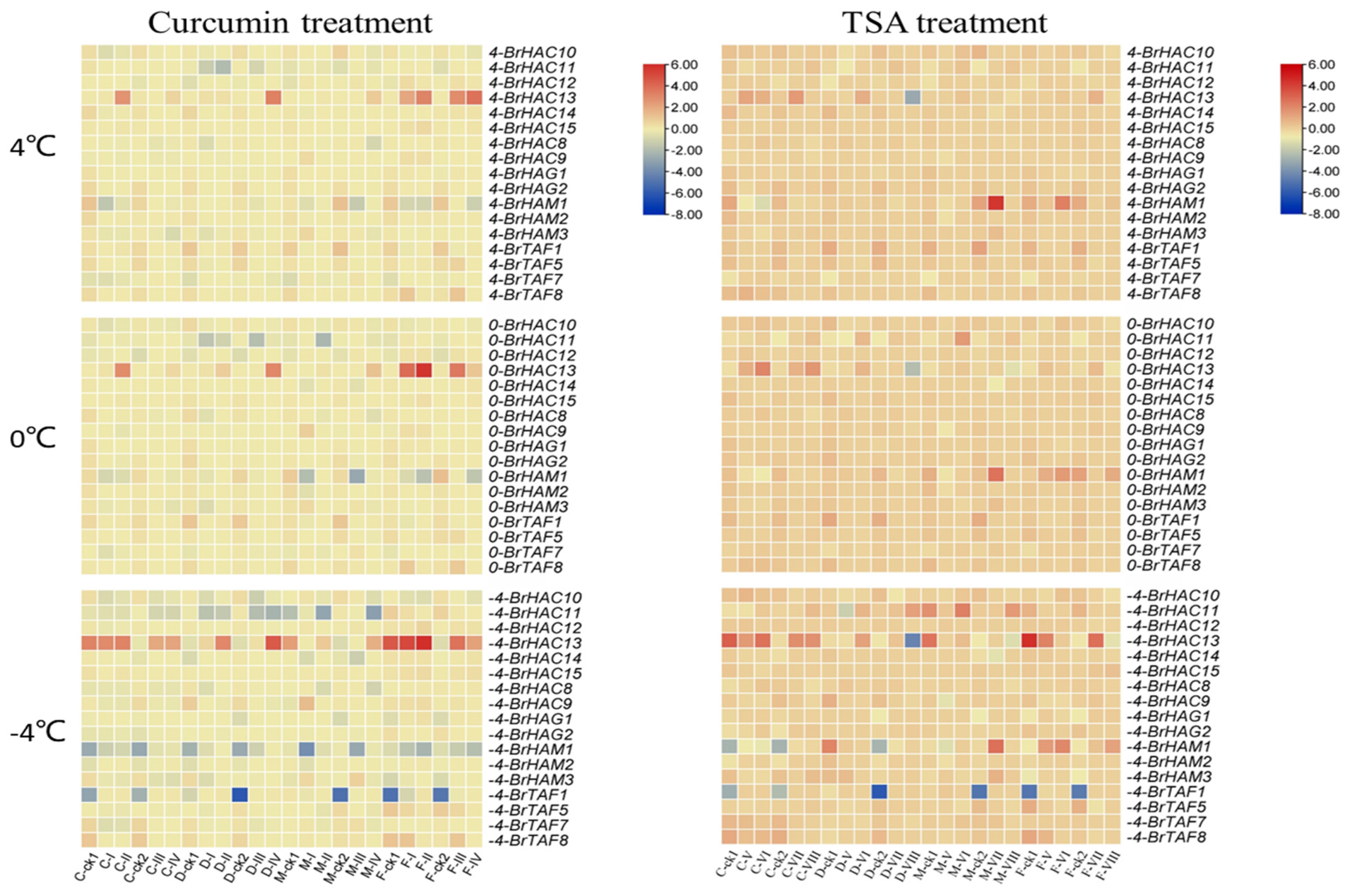
| Gene Name | Sequence ID | Number of Amino Acid | Molecular Weight/kDa | pI | Instability Index | Hydrophilia | Aliphatic Index |
|---|---|---|---|---|---|---|---|
| BrHAC1 | Brapa01T000131.1 | 374 | 42,686.6 | 9.08 | 55.25 | 84.41 | −0.336 |
| BrTAF1 | Brapa01T003430.1 | 1772 | 201,196.61 | 5.69 | 54.09 | 70.56 | −0.799 |
| BrTAF2 | Brapa01T003498.1 | 305 | 34,158.23 | 6.94 | 28.92 | 102.26 | −0.429 |
| BrHAC9 | Brapa01T003886.1 | 1637 | 184,450.74 | 8.85 | 50.11 | 66.76 | −0.671 |
| BrHAC10 | Brapa02T001822.1 | 1012 | 116,033 | 8.01 | 44.88 | 70.3 | −0.565 |
| BrHAC11 | Brapa02T002581.1 | 1653 | 185,472.72 | 8.71 | 57.08 | 62.03 | −0.737 |
| BrHAC2 | Brapa02T004562.1 | 368 | 41,825.9 | 9.45 | 64.14 | 87.39 | −0.313 |
| BrTAF3 | Brapa03T002862.1 | 305 | 34,192.25 | 6.94 | 29.2 | 100.98 | −0.434 |
| BrHAC12 | Brapa03T003605.1 | 1603 | 181,371.88 | 8.81 | 52.63 | 65.31 | −0.679 |
| BrHAC3 | Brapa03T006148.1 | 379 | 43,316.25 | 8.92 | 54.44 | 83.83 | −0.405 |
| BrHAG1 | Brapa04T000545.1 | 525 | 59,015.22 | 6.09 | 41.82 | 70.1 | −0.62 |
| BrHAG2 | Brapa04T000549.1 | 548 | 60,926.09 | 6.13 | 40.5 | 69.29 | −0.624 |
| BrTAF4 | Brapa05T002439.1 | 229 | 25,685.49 | 6.86 | 29.17 | 100.87 | −0.431 |
| BrHAC8 | Brapa06T001216.1 | 990 | 110,352.88 | 6.71 | 51.87 | 69.22 | −0.598 |
| BrHAM1 | Brapa06T002435.1 | 160 | 18,855.76 | 6.17 | 48.73 | 79.25 | −0.456 |
| BrTAF5 | Brapa06T002581.1 | 381 | 42,699.02 | 7 | 29.22 | 101.05 | −0.436 |
| BrHAC4 | Brapa06T002586.1 | 380 | 43,636.84 | 9.16 | 44.78 | 82.84 | −0.357 |
| BrHAC13 | Brapa07T003346.1 | 876 | 100,268.81 | 6.36 | 57.76 | 75.21 | −0.509 |
| BrTAF6 | Brapa08T000884.1 | 1893 | 213,267.71 | 5.35 | 52.28 | 72.09 | −0.816 |
| BrTAF7 | Brapa08T001640.1 | 229 | 25,685.49 | 6.86 | 29.17 | 100.87 | −0.431 |
| BrHAC14 | Brapa08T003011.1 | 1578 | 176,696.25 | 8.74 | 53.39 | 64.27 | −0.724 |
| BrHAC5 | Brapa08T003012.1 | 297 | 32,073.09 | 6.76 | 57.55 | 75.52 | −0.525 |
| BrHAC6 | Brapa08T003480.1 | 369 | 41,612.29 | 9.3 | 52.74 | 81.36 | −0.341 |
| BrHAC15 | Brapa09T000822.1 | 1653 | 183,826.65 | 8.72 | 50.79 | 65.36 | −0.667 |
| BrTAF8 | Brapa09T004162.1 | 229 | 25,685.49 | 6.86 | 29.17 | 100.87 | −0.431 |
| BrHAM2 | Brapa09T005768.1 | 465 | 54,007.8 | 6.81 | 44.2 | 83.2 | −0.515 |
| BrHAM3 | Brapa10T000566.1 | 441 | 50,864.11 | 7.56 | 40.61 | 78.25 | −0.619 |
| BrHAC15 | Brapa10T001880.1 | 1712 | 192,652.85 | 5.58 | 42.45 | 90.95 | −0.21 |
| BrHAC7 | Brapa10T002727.1 | 955 | 106,960.73 | 8.11 | 46.98 | 89.75 | −0.155 |
Disclaimer/Publisher’s Note: The statements, opinions and data contained in all publications are solely those of the individual author(s) and contributor(s) and not of MDPI and/or the editor(s). MDPI and/or the editor(s) disclaim responsibility for any injury to people or property resulting from any ideas, methods, instructions or products referred to in the content. |
© 2024 by the authors. Licensee MDPI, Basel, Switzerland. This article is an open access article distributed under the terms and conditions of the Creative Commons Attribution (CC BY) license (https://creativecommons.org/licenses/by/4.0/).
Share and Cite
Bian, L.; Fahim, A.M.; Wu, J.; Liu, L.; Pu, Y.; Ma, L.; Fang, Y.; Zhang, D.; Yang, G.; Wang, W.; et al. Systematic Analysis of the BrHAT Gene Family and Physiological Characteristics of Brassica rapa L. Treated with Histone Acetylase and Deacetylase Inhibitors under Low Temperature. Int. J. Mol. Sci. 2024, 25, 9200. https://doi.org/10.3390/ijms25179200
Bian L, Fahim AM, Wu J, Liu L, Pu Y, Ma L, Fang Y, Zhang D, Yang G, Wang W, et al. Systematic Analysis of the BrHAT Gene Family and Physiological Characteristics of Brassica rapa L. Treated with Histone Acetylase and Deacetylase Inhibitors under Low Temperature. International Journal of Molecular Sciences. 2024; 25(17):9200. https://doi.org/10.3390/ijms25179200
Chicago/Turabian StyleBian, Liang, Abbas Muhammad Fahim, Junyan Wu, Lijun Liu, Yuanyuan Pu, Li Ma, Yan Fang, Dan Zhang, Gang Yang, Wangtian Wang, and et al. 2024. "Systematic Analysis of the BrHAT Gene Family and Physiological Characteristics of Brassica rapa L. Treated with Histone Acetylase and Deacetylase Inhibitors under Low Temperature" International Journal of Molecular Sciences 25, no. 17: 9200. https://doi.org/10.3390/ijms25179200





